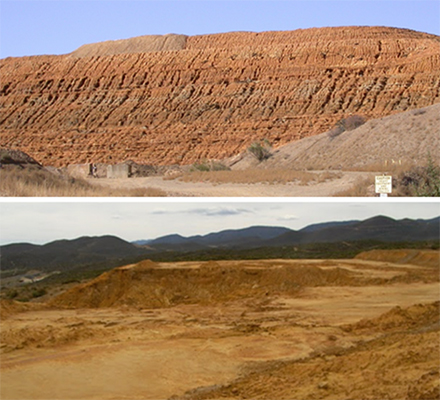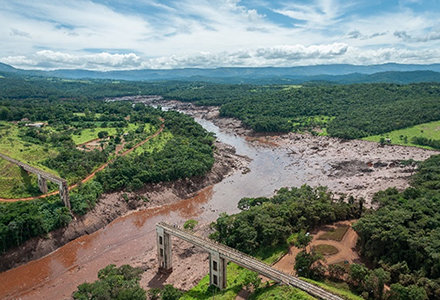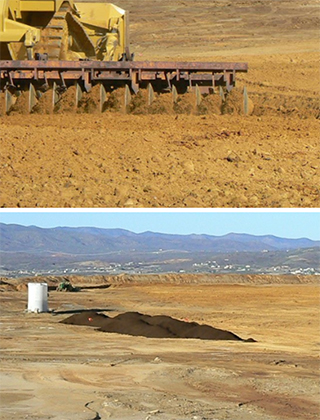By Julie Leibach

For the past two decades, researchers with the University of Arizona Superfund Research Program (SRP) Center have been studying human exposures to mining waste and how to improve site remediation in the Southwest.
Funded by NIEHS, the team is also exploring ways to meet future mineral demands by mining an unconventional source: the waste itself.
"If you think about it, the green economy will rely on electrification, which is batteries, which is mining," said Raina Maier, Ph.D., SRP Center director. "The question is, how can we do it with the least impact on the earth and on neighboring communities?"
Mineral mining generates the largest waste stream on the planet. That refuse takes two primary forms: piles of rock removed when digging for ore, and tailings - pulverized rock left over from mineral extraction.
Of more than 150 billion metric tons of rock mined each year, the industry produces around 85 billion metric tons of waste rock and tailings, according to a 2022 United Nations (UN) report . For perspective, that amount of waste roughly equals the weight of 257,000 Empire State buildings .
Those numbers do not account for the remains of abandoned, or legacy, mines. On federal lands, at least 22,500 legacy hardrock mine features - such as toxic waste piles - could be environmental hazards , the U.S. Government Accountability Office reported in 2020. Thousands more legacy mines exist globally , according to the Encyclopedia of Environmental Health.
Toxic Tailings
Digging In Together
In 2011, with SRP funding, Maier co-founded the Center for Environmentally Sustainable Mining , or CESM, as a bridge between researchers and mining companies. The focus is on developing more sustainable methods to satisfy growing mineral demand in the U.S.
A couple years later, CESM formed a research cooperative, now primarily funded by the mining industry, as an opportunity for mining companies to participate in research. All data is shared among members to hasten development of improved sustainability practices.
"We pitch ideas to the mining companies and listen to what technologies they need to address their environmental concerns," explained center director Julie Neilson, Ph.D. "Then we go back to the academics to see whose expertise aligns with specific topics."
In one project, for example, a University of Arizona climate scientist is attempting to quantify how much carbon can be captured by revegetated tailings based on site location and species planted. The findings could inform an incentive program for mining companies to offset energy costs by investing in strategic plantings.
"It's incumbent on mining companies to build back the land they've disrupted," Neilson said. "In general, I've been really impressed by their interest and desire to mine more sustainably."
Legacy and active mines pose various risks to environmental and human health.
Tailings can contain compounds called iron sulfides that, upon contact with air, undergo a chemical reaction that forms acid - a process hastened by soil bacteria. That acid can drain from mismanaged active or abandoned mines into nearby streams and rivers, leaching heavy metals along the way. Fish and their predators are at risk of metal exposure, as well as humans who rely on those waterways for food, irrigation, and recreation.
Legacy mine tailings can also contain residual metals that hitchhike on wind to neighboring communities.
"Many abandoned sites were mined a long time ago, when technology was cruder and left more metal, like arsenic, lead, zinc, and cadmium, in the tailings," Maier explained. "As wind erodes barren mines, people living nearby can be exposed to these metals."
Several years ago, the University of Arizona SRP Center studied exposures of children living near the defunct Iron King Mine and Humboldt Smelter , a designated Superfund site. The researchers found that, in many participating homes, arsenic levels in drinking water, yard soil, and indoor dust were above recommended levels . In addition, arsenic levels in most urine samples from children in the study were higher than what is typical for kids in the U.S.
In areas where mining takes place, however, attributing arsenic exposure to a source can be tricky, Maier noted.
"In addition to arsenic from mining activities, groundwater can have naturally high amounts of arsenic," she explained.
Arsenic is a carcinogen associated with liver, kidney, bladder, lung, and skin cancers. Exposure has also been linked to diabetes. Center researchers are now investigating how arsenic in mining dust affects biologic pathways involved in diabetes onset.
"Native Americans and Hispanics in the Southwest have a higher rate of diabetes than Native Americans and Hispanics elsewhere in the United States," Maier said. "Those are both populations that are underserved and disproportionately exposed to mining waste, because mining often occurs near their communities."
The team is also examining how geology affects arsenic bioaccessibility - the amount that can be absorbed by an organism.
"We are looking at different types of particles that contain arsenic and exposing mice to that material," Maier said. "For some minerals, the arsenic is bound very tightly, so exposure is minimal."
Dust Busting

On January 25, 2019, a tailings storage facility in Brumadinho, Brazil, collapsed, unleashing over 3 million gallons of mining waste that killed more than 250 people. The disaster sparked an international effort to develop a global industry standard on tailings management , released in 2020. In striving for "zero harm to people and the environment," the standard reflects a growing trend toward environmental, social, and governance (ESG) investing - essentially, backing companies with ethical business practices.
"Without development of ESG standards, new mining efforts have little chance to get the funding that they need to develop their projects," Maier said.
For legacy tailings, a standard remediation practice in the U.S. is "cap and plant," which involves placing a soil cover over the tailings to control dust and encourage plant growth. Maier's team is studying how to optimize the process, because mines typically have low revegetation success rates.
" Our work is showing that you really need to evaluate what chemicals or elements are mingling with the tailings, then decide how deep to make the cap, and which capping material to use," she said. "Importantly, you do not need to necessarily replace the original plant cover. Different plants can get the job done."

Maier and colleagues also helped pioneer another technology for mine sites called phytostabilization, which entails adding nutrients, such as compost, directly into tailings. The process transforms the waste - which is typically devoid of nutrients - into a plant-supporting medium. The approach could one day be an alternative to cap and plant, which requires substantial resources to implement, Maier explained.
Results from a 10-year study conducted at the highly acidic Iron King Mine and Humboldt Smelter Superfund site showed that tailings amended with compost led to successful plant establishment . However, a related study revealed that, over time, microbes that thrive in acidic environments eventually outcompeted those that support vegetation .
"There is a war that goes on between microbe communities, and who wins will decide if the plants establish or don't establish," said Maier, who is a microbiologist by training. "The findings suggest that compost should be applied periodically to a site to encourage plant survival."
Treasure in Trash
Given the growing demand for elements, Maier's team is also exploring alternative mining strategies. Instead of massive machines crushing rock, she envisions mining liquid waste.
"Some bacteria make molecules that bind metals really well, and we are trying to use those molecules to recover things like rare earth elements out of acid mine drainage," Maier said. " We've done some calculations showing that this method could go a long way to meeting U.S. demand."
She sees these metal-binding molecules as a promising alternative to various energy- and resource-intensive activities. As co-founder of GlycoSurf, a company originally supported by an NIEHS Small Business Innovation Research Grant, Maier has patented several technologies that harness microbial power for personal and industrial use, like body wash and dust suppression. Mining could be on the horizon.
"We can't live without mining," she said. "But I think there's a lot of interest now in approaching it in a more sustainable manner."


